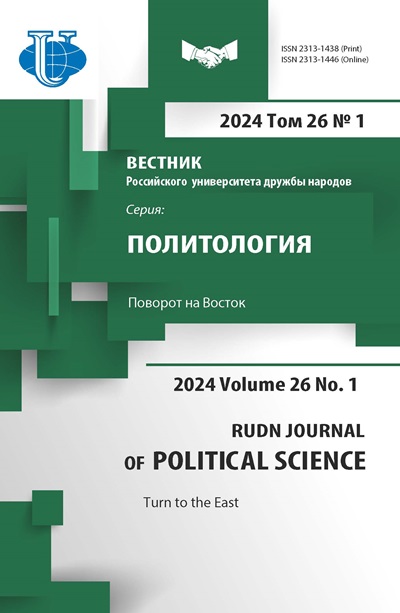Образы России и Китая во взаимных представлениях российской и китайской молодежи
- Авторы: Сорокина А.А.1, Максименкова М.С.1
-
Учреждения:
- Национальный исследовательский университет «Высшая школа экономики»
- Выпуск: Том 22, № 1 (2020)
- Страницы: 144-160
- Раздел: АКТУАЛЬНЫЕ ВОПРОСЫ ПОЛИТИЧЕСКОЙ НАУКИ
- URL: https://journals.rudn.ru/political-science/article/view/23284
- DOI: https://doi.org/10.22363/2313-1438-2020-22-1-144-160
Цитировать
Полный текст
Аннотация
Российско-китайские отношения находятся в центре внимания исследователей международных отношений. Тем не менее изучение представлений россиян о Китае и китайцев о России в работах представлено недостаточно. Данная работа нацелена на то, чтобы восполнить этот пробел. В фокусе - взаимные представления о странах среди студенческой молодежи. В основе работы лежит анализ 150 глубинных интервью, проведенных с китайскими студентами, специализирующимися на изучении России, и российскими студентами, специализирующимися на изучении Китая (по 75 в каждой группе). В статье показано, что во взаимных представлениях друг о друге преобладают стереотипы, а определяющим фактором в развитии российско-китайских отношений респонденты из обеих стран считают российского президента В.В. Путина.
Ключевые слова
Об авторах
Анна Андреевна Сорокина
Национальный исследовательский университет «Высшая школа экономики»
Автор, ответственный за переписку.
Email: aasorokina@hse.ru
кандидат политических наук, ведущий научный сотрудник Института прикладных политических исследований, доцент факультета социальных наук
Мясницкая улица, д. 20, Москва, Россия, 101000Марина Сергеевна Максименкова
Национальный исследовательский университет «Высшая школа экономики»
Email: mmaksimenkova@hse.ru
директор Центра политических исследований и экспертизы Института прикладных политических исследований, преподаватель факультета социальных наук
Мясницкая улица, д. 20, Москва, Россия, 101000Список литературы
- Rossiya - Kitaj - SSHA: otnosheniya v strategicheskom treugol'nike’. Russian Public Opinion Research Centre (WCIOM), (7 February 2017). Available from: https://wciom.ru/ index.php?id=236&uid=116055. Accessed 11.06.2018 (In Russ.).
- Noll J., Dekker H. A Comparative Analysis of Chinese urban Citizens’ attitudes towards the EU, the United States, Russia and Japan. International Relations. 2016; 30 (4): 456-472.
- Syed N.A. The Effect of Beijing 2008 on China’s Image in the United States: A Study of US Media and Polls. The International Journal of the History of Sport. 2010; 27 (16-18): 2863- 2892.
- Xie T., Page B.I. What Affects China’s National Image? A cross-national study of public opinion. Journal of Contemporary China. 2013; 22(83): 850-867.
- Fedorova K. Speaking With and About Chinese Language Attitudes, Ethnic Stereotypes and Discourse Strategies in Interethnic Communication on the Russian-Chinese Border. Civilisations. 2013; 62 (1-2): 71-89.
- Curanovic A. Why don’t Russians fear the Chinese? The Chinese factor in the selfidentification process of Russia. Nationalities Papers. 2012; 40 (2): 221-239.
- Dong L. Chinese Perceptions of the European Union. Journal of Contemporary China. 2014; 23 (88): 756-779.
- Ghazarian P.G. Country Image and the Study Abroad Destination Choice of Students from Mainland China. Journal of International Students. 2016; 6(3): 700-711.
- Katz D., Braly K. Racial stereotypes of one hundred college students. The Journal of Abnormal and Social Psychology. 1933; 28(3): 280-290.
- Bersick S. Perceptions of Asia in Europe. Asia Europe Journal. 2010; 8 (2): 244-255.
- Ng S.H., Ye J., Lee C. Media Discourse on Globalization in China: A Social-Psychological Analysis. Journal of Language and Social Psychology. 2011; 30 (2): 139-157.
- Zhang L. Stereotypes of Chinese by American college students: media use and perceived realism. International Journal of Communication. 2015; 9: 1-20.
- Blagojević G. Contemporary Serbian stereotypes about the Chinese in Belgrade: When you say China, I think about Block 70 or… Zbornik Matice srpske za drustvene nauke. 2009; 129: 47-6.
- Boden J. Mass media: Playground of stereotyping. International Communication Gazette: Formerly Gazette. 2016; 78 (1-2): 121-136.
- Li X., Worm V. Building China’s Soft Power for a Peaceful Rise. Journal of Chinese Political Science. 2011; 16 (1): 69-89.
- Hartig F. Confucius Institutes and the Rise of China. Journal of Chinese Political Science. 2012; 17 (1): 53-76.
- McKercher B. The Roots of Stereotypes about Tourists. Society. 2008; 45: 345-347.
- Nikitina L., Furuoka F. ‘Dragon, kung fu and Jackie Chan..’: stereotypes about China held by Malaysian students. Trames. A Journal of the Humanities and Social Sciences. 2013; 17 (2) (67/62): 175-195.
- Zhilina L. Public attitude and mutual perceptions: Japan and Russia. Political Science Journal. 2015; 10 (1-2): 1-30.
- Bukh A. Russia's Image and Soft Power Resources in Southeast Asia: Perceptions among Young Elites in Laos, Thailand and Vietnam. Contemporary Southeast Asia: A Journal Of International & Strategic Affairs. 2016; 38 (3): 445-475.
- Vasil'eva K., Ostrovskij A., Alagueva T. The Image of Russians in the Eyes of the Chinese and the Image of the Chinese in the Eyes of Russians on Contiguous Territory. Far Eastern Affairs. 2007; 35 (4): 104-114.
- Hsia T.A. Demons in Paradise: The Chinese Images of Russia. The Annals of the American Academy. 1963; 349: 27-37.
- Lukin A. Russia's Image of China and Russian-Chinese Relations. East Asia. 1999; 17 (1): 5-39.
- Bislev A. Student-to-Student Diplomacy: Chinese International Students as a Soft-Power Tool. Journal of Current Chinese Affairs. 2017; 2: 81-109
















